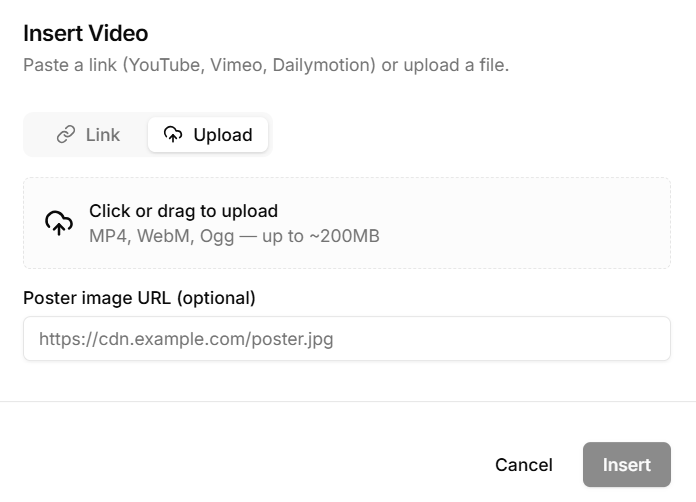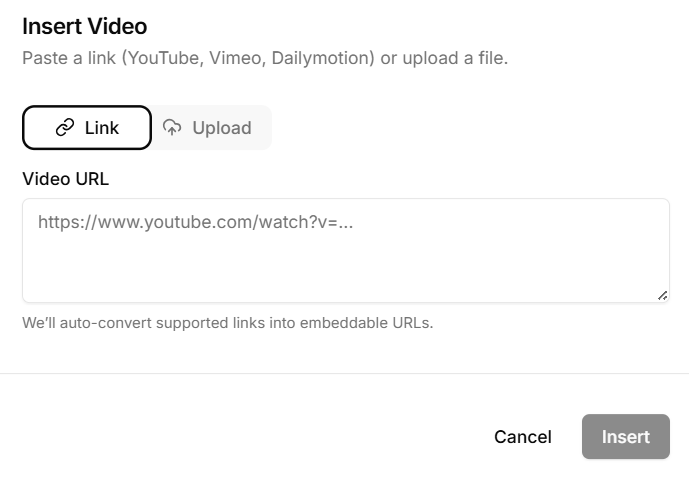Uploading / embedding video in articles
Like images, video can be easily embedding into your knowledge base articles. HelpSite offer multiple options for adding videos into your articles.
Videos can be embedded by URL, embedded via an "embed code", or uploaded directly through our WYSIWYG article editor.
Embed videos from a dedicated video platform (recommended)
For best results, we recommend you upload your videos to a video hosting site such as YouTube, Vimeo, Vidyard, or Wistia, and then to use their embed features to allow your videos to show nicely in your HelpSite articles.
Videos from YouTube, Vimeo, or Vidyard
For many video providers (YouTube, Vimeo, Vidyard), you can simply paste the URL of the video into the spot shown below:

For YouTube, Vimeo, and Vidyard videos added in this way (starting August 19, 2022), they will be inserted to display responsively by default. That means the size will automatically adjust smaller for mobile devices.
Note: If you're using Vimeo and you're getting a "Something went wrong" error, ensure the URL you're pasting looks like https://vimeo.com/123456. If it instead looks like https://vimeo.com/showcase/654321/video/123456 then please change the URL to just keep the number at the end and cut off the middle part
Videos from Wistia
To embed videos hosted by Wistia, you should use their Fallback (Iframe) Embed code, as described in the Wistia documentation.
This embed code should have a line like "<iframe ...></iframe>", which is what you want to copy. A full example of the code looks like this:
<iframe src="//fast.wistia.net/embed/iframe/avk9twrrbn" allowtransparency="true" frameborder="0" scrolling="no" class="wistia_embed" name="wistia_embed" allowfullscreen mozallowfullscreen webkitallowfullscreen oallowfullscreen msallowfullscreen width="620" height="349"></iframe>NOTE: Do not copy the line that includes "<script ...></script>". You should only copy the "iframe" tag. If you include the script tag, you'll get an error message "Something went wrong. Please try again".
Paste the iframe tag snippet into the "Embedded Code" textbox shown in the screenshot above.
Videos from other video hosting platforms
For other video hosting providers, you'll want to grab their "embed code" and paste it in the appropriate option:

However you should always use an "iframe" type of embed code rather than a "script tag" embed code.
Upload videos directly
Alternatively, you are able to upload videos directly to HelpSite. Our current per-file upload size restriction is 10MB and supports mp4, webm, and ogg file types.
There are a few downsides to uploading videos directly to HelpSite. In addition to the restriction on file size and file types, videos uploaded directly will not have the same behind-the-scenes compression and format intelligence that professional video hosting websites do to serve the right video size and format to each user and stream it as quickly as possible.
Adjusting the size your videos are displayed
Responsive by default (YouTube, Vimeo, Vidyard)
For videos inserted by URL from YouTube, Vimeo, or Vidyard, those videos will be displayed responsively automatically.
This means that they automatically appear at an appropriate size depending on the viewer's device type. That way they don't appear too large on phones, and you also don't have to resize down every video to make that happen. If your browser is wider, the videos will be wider, but if your browser is more narrow, the videos will resize down automatically to fit the narrower browser size.
This change applies to videos from those platform embedded into a HelpSite article anytime since August 19, 2022. If you have an older YouTube/Vimeo/Vidyard video that you want displayed responsively, just remove it and re-embed it by URL.
If for some reason you would prefer to limit the maximum width of your responsively displayed videos, get in touch and we can help you apply some Custom CSS to your site.
Manually resizing other video types
For videos inserted another way, you can manually adjust the size of the video.
For non-responsive videos, you should be able to change the size the video player is presented at, either by dragging one of the blue corners, or by clicking "Change Size" and then entering a width & height in number of pixels.

Displaying other videos responsively
If your video is not hosted by YouTube/Vimeo/Vidyard, and you want it to appear responsively rather than as a set number of pixels for width/height, this section is for you.
It is possible to also make your iframe videos be embedded responsively at 100% width while maintaining a correct aspect ratio.
For embedding other videos responsively, you'll need to insert code like this:
<span class="fr-video fr-fvc fr-dvi fr-draggable" contenteditable="false" style="display: block; position: relative; padding-bottom: 56.25%; height: 0; overflow: hidden; max-width: 100%;"><iframe src="https://www.youtube.com/embed/QILiHiTD3uc" style="position: absolute; top: 0; left: 0; width: 100%; height: 100%;" frameborder="0" allowfullscreen="" class="fr-draggable"></iframe></span>This code snippet needs to be pasted via the Code View in the article editor, rather than by pasting it in the Insert Video widget as described in the other methods used above.
If you have any questions or need help, please do contact us!
